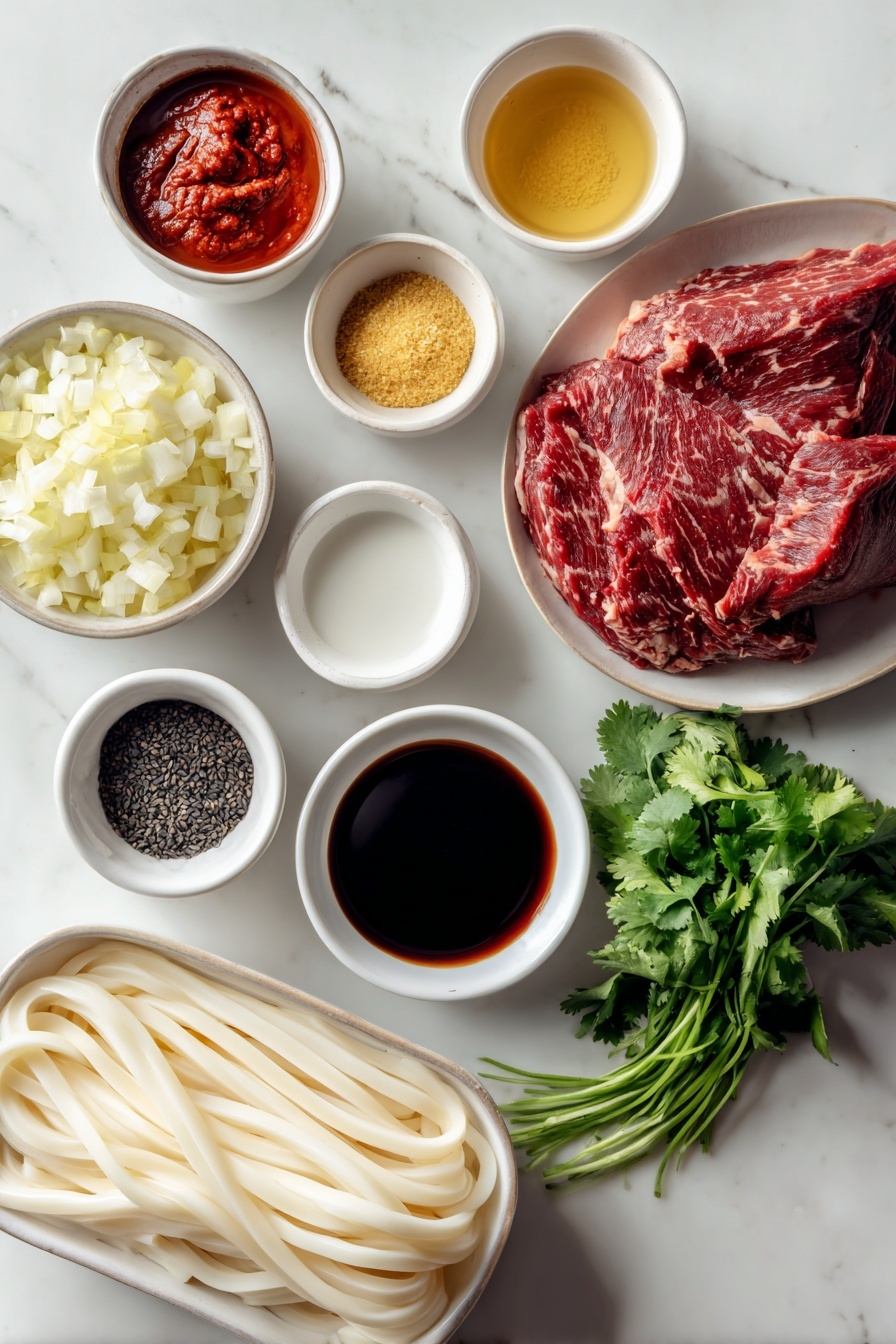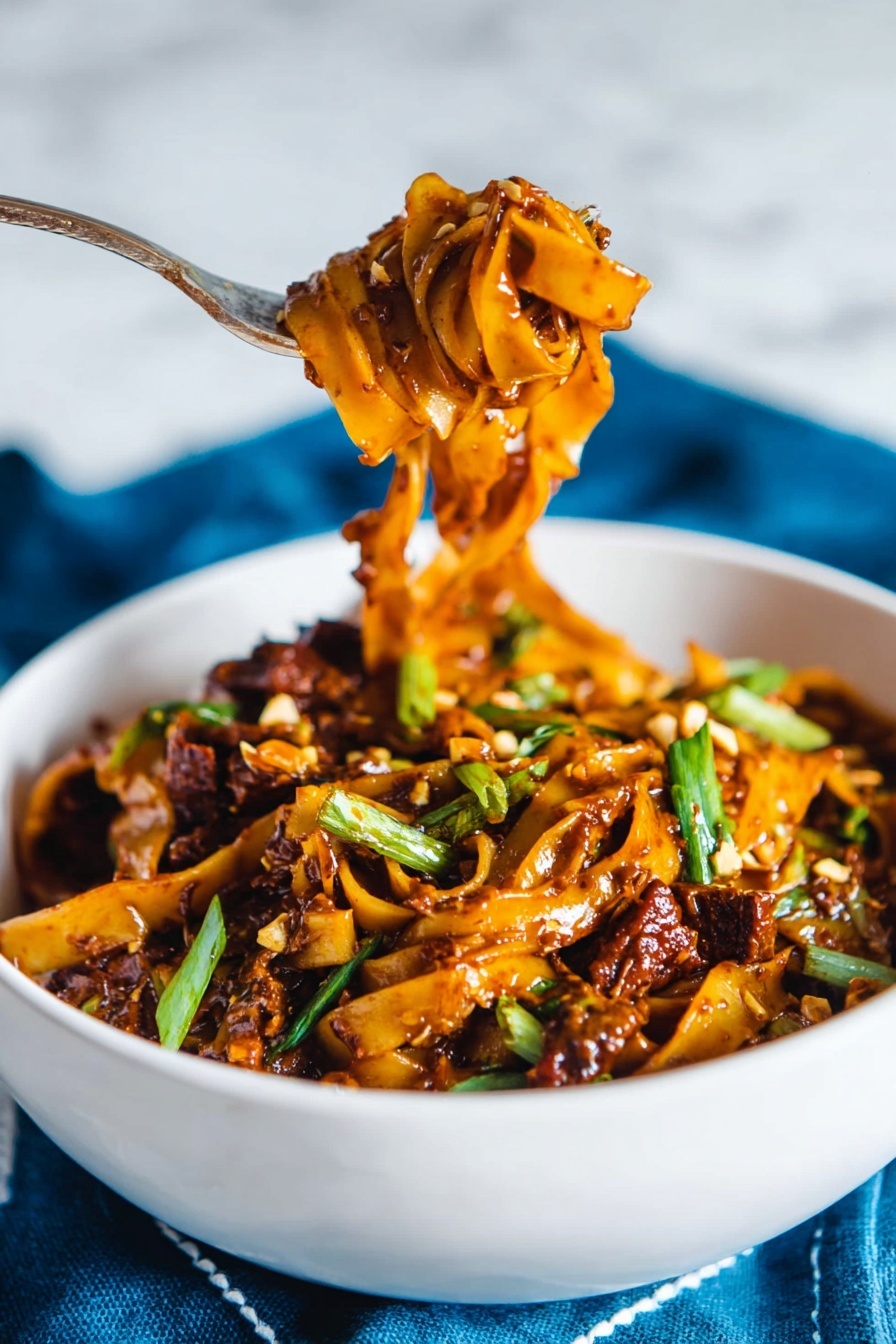The moment you open the slow cooker and catch that rich, savory aroma is pure magic. This Slow Cooker Korean Beef Noodles Recipe isn’t just comforting; it’s a blend of bold flavors and melt-in-your-mouth beef that makes weeknight dinners something to look forward to.
Jump to:
Why You'll Love This Recipe
I remember the first time I made this recipe—it was a chilly weekend, and the house quickly filled with the deep, spicy scent of Korean spices and slow-cooked beef. What makes this dish stand out is just how effortlessly the flavors meld while the meat gets fork-tender without you needing to be glued to the stove.
- Effortless Slow Cooking: Toss everything in and let the slow cooker do all the work for tender, flavorful beef.
- Balanced Korean Flavors: The combination of gochujang, soy, and rice vinegar creates a perfect sweet, spicy, and tangy sauce.
- Quick Finishing Touch: Adding udon noodles at the end means they cook just enough—soft but not mushy.
- Customizable Comfort Food: Easily swap meats or adjust spice levels to suit your taste, making it truly yours.

Ingredients & Why They Work
Every ingredient in this Slow Cooker Korean Beef Noodles Recipe plays a part in creating that deep, multi-layered taste you crave. When you pick your ingredients thoughtfully, the end result feels richly authentic yet incredibly simple.

- Large Onion: Adds sweetness and a bit of texture that mellows beautifully as it cooks down.
- Gochujang: That spicy-sweet Korean chili paste is the heart of the dish, giving it its signature kick.
- Dark Soy Sauce: Brings depth and umami without overpowering the other flavors.
- Rice Vinegar: A subtle acidity to balance the richness of the beef and the sweetness from sugar.
- Light Brown Sugar: Enhances the caramelization and rounds out the tangy and spicy notes.
- Garlic Ginger Paste: Packed with flavor, it infuses warmth and aroma effortlessly.
- Tomato Paste: Gives a subtle tang and adds body to the sauce, working well with the richness of the meat.
- Low-Sodium Beef Stock: Keeps things juicy and adds savory depth without making the dish too salty.
- Ox Cheek (or alternatives like ox tail, short ribs, chuck roast): Cuts that become ultra-tender and richly flavored after slow cooking.
- Ready-to-Use Udon Noodles: Convenient and perfect for soaking up the sauce without falling apart.
- Fresh Coriander: Adds a fresh, herbaceous brightness to contrast the rich sauce.
- Black Sesame Seeds: A nutty crunch that’s a simple but beautiful finishing touch.
- Kosher Salt and Black Pepper: To adjust seasoning perfectly at the end.
Make It Your Way
I love experimenting with this recipe depending on the mood and ingredients I have on hand. Feel free to get creative with protein swaps or spice levels—this dish is forgiving and flexible.
- Variation: One time I swapped ox cheek for short ribs, and it was equally amazing—maybe even faster to shred. If you like a bit more heat, adding a teaspoon of extra gochujang or some crushed red pepper flakes really amps up the kick.
- Dietary swaps: For a leaner version, chuck roast works well, and you can add mushrooms or tofu for some extra texture without extra meat.
- Seasonal changes: Adding some sautéed bok choy or spinach halfway through cooking makes this meal green and fresh.
Step-by-Step: How I Make Slow Cooker Korean Beef Noodles Recipe
Step 1: Build Your Flavor Base
Start by mixing the finely diced onion with gochujang, dark soy sauce, rice vinegar, light brown sugar, garlic-ginger paste, tomato paste, and beef stock right in the slow cooker. Stir this until it’s all blended. This mix is your flavor powerhouse, so be sure it’s evenly combined—no clumps of paste hiding anywhere!
Step 2: Add the Beef and Slow Cook
Place the ox cheek directly on top of the sauce mixture, turning it to coat the meat well in those lovely flavors below. Pop on the lid and set your slow cooker to low for about 8 hours. This slow and steady method gives the meat that fall-apart tenderness that’s absolutely dreamy.
Step 3: Shred and Sauce It Up
Once your 8 hours are up, lift out the beef and shred it with two forks right in the cooker or on a plate. Return the shredded meat to the sauce juices—don’t waste those! This step helps the beef soak up even more flavor from the sauce before you add the noodles.
Step 4: Finish with Noodles and Herbs
Add your ready-to-use udon noodles and the chopped coriander into the slow cooker. Turn the heat to high and cook for another 25 minutes. This way, the noodles absorb just enough sauce without getting mushy. Season with salt and pepper, then sprinkle black sesame seeds on top for a nutty crunch.
Top Tip
Over the years, I’ve learned that the secret to perfectly tender beef and saucy noodles lies in layering flavors and timing the noodle addition just right. Here are my favorite tips from cooking this recipe again and again:
- Low and Slow Cooking: Stick to the 8-hour low setting—you want the meat to gently break down without drying out.
- Coat the Meat Well: Turn your beef in the sauce before cooking to ensure every bite is infused with flavor.
- Don’t Overcook the Noodles: Add udon only at the end so they stay chewy and don’t fall apart into the sauce.
- Season Last: Taste before adding salt and pepper since soy sauce and stock already bring saltiness.
How to Serve Slow Cooker Korean Beef Noodles Recipe

Garnishes
I always go for fresh coriander because it adds that sudden pop of brightness to the rich dish. A sprinkle of black sesame seeds not only looks gorgeous but gives a lovely crunch that contrasts the tender beef and noodles perfectly.
Side Dishes
Kimchi is my go-to side. Its spicy, tangy character pairs beautifully and cuts through the richness. Sometimes I add a simple cucumber salad with a sesame oil dressing for crunch and coolness, too.
Creative Ways to Present
For a dinner party, I love plating the noodles in shallow bowls, then topping them with a soft boiled egg and some thinly sliced scallions. It looks stunning and adds extra texture layers. You can even serve it alongside steamed buns for a fun fusion twist.
Make Ahead and Storage
Storing Leftovers
I usually keep leftovers in an airtight container in the fridge for up to 3 days. The flavors deepen overnight, so the next-day meal almost tastes better. Just be mindful—storing the noodles separately helps avoid too much sogginess.
Freezing
This recipe freezes well if you freeze the shredded beef and sauce separately from the noodles. Thaw overnight in the fridge, then reheat gently on the stove, adding freshly cooked noodles or reheating the frozen ones carefully to keep their texture.
Reheating
Reheat slowly on low in a saucepan to prevent drying out. Adding a splash of beef stock or water helps loosen the sauce if it’s thickened too much in the fridge. If noodles were stored separately, reheat them briefly in hot water or pan-fry with a little sesame oil for added flavor.
Frequently Asked Questions:
Absolutely! If you can’t find ox cheek, short ribs, chuck roast, or oxtail are great substitutes. Just adjust the cooking time if the cut is leaner or thicker to make sure the meat is tender.
Ready-to-use udon noodles work perfectly because they hold their shape and absorb flavors well during the last step of cooking. If you can’t find udon, thick egg noodles or fresh rice noodles can also work with adjustments to cooking time.
The dish has a mild to moderate heat level mainly coming from the gochujang chili paste. You can easily adjust the spice by adding more or less gochujang or including extra chili flakes if you prefer it hotter.
Yes! The beef and sauce can be made up to 24 hours ahead and stored in the fridge. Add the noodles only when you’re ready to serve to keep their texture fresh.
Final Thoughts
This Slow Cooker Korean Beef Noodles Recipe has become one of my absolute favorites for busy days when I want something hearty but fuss-free. It feels like a hug in a bowl, layered with rich, spicy, and tangy goodness that never gets old. I genuinely hope you give it a go and find the same cozy joy I do—it’s like having a taste of Korea without leaving your kitchen!
Print
Slow Cooker Korean Beef Noodles Recipe
- Prep Time: 15 minutes
- Cook Time: 8 hours 25 minutes
- Total Time: 8 hours 40 minutes
- Yield: 4 servings
- Category: Main Course
- Method: Slow Cooking
- Cuisine: Korean
Description
A rich and flavorful Slow Cooker Korean Beef Noodles recipe featuring tender ox cheek slow-cooked in a savory gochujang and soy-based sauce, combined with udon noodles and garnished with fresh coriander and black sesame seeds for a comforting and delicious meal.
Ingredients
Beef and Sauce
- 1 large onion, finely diced
- 2 tablespoons gochujang
- 2 tablespoons dark soy sauce
- 2 tablespoons rice vinegar
- 1 tablespoon packed light brown sugar
- 1 tablespoon garlic ginger paste
- 1 tablespoon tomato paste
- 3 ½ ounces low-sodium beef stock
- 14 ounces ox cheek (or ox tail, short ribs, or chuck roast)
Noodles and Garnish
- 4 pouches ready-to-use (ready-to-wok) udon noodles
- 1 to 2 tablespoons roughly chopped fresh coriander
- 1 tablespoon black sesame seeds, for garnish
- Kosher salt and freshly cracked black pepper, to taste
Instructions
- Prepare the sauce: In the slow cooker, combine the diced onion, gochujang, dark soy sauce, rice vinegar, light brown sugar, garlic ginger paste, tomato paste, and low-sodium beef stock. Stir the mixture well until all ingredients are incorporated.
- Add and coat the beef: Place the ox cheek on top of the sauce mixture in the slow cooker, ensuring all sides of the meat are coated with the sauce.
- Slow cook the beef: Cover the slow cooker with its lid and cook on low heat for 8 hours, allowing the beef to become tender and flavorful.
- Shred the beef: After 8 hours, remove the beef and shred it using two forks. Return the shredded meat to the slow cooker and mix with the sauce.
- Add noodles and coriander: Add the ready-to-use udon noodles and roughly chopped fresh coriander to the slow cooker. Cook on high heat for an additional 25 minutes to heat the noodles through and blend flavors.
- Season and garnish: Season the dish with kosher salt and freshly cracked black pepper to taste. Garnish with black sesame seeds before serving.
- Serve and enjoy: Spoon the Korean beef noodles into bowls and enjoy a hearty and comforting meal.
Notes
- You can substitute ox cheek with ox tail, short ribs, or chuck roast if unavailable.
- If fresh coriander is not available, chopped green onions can be used as an alternative garnish.
- Use low-sodium beef stock to control the salt content of the dish.
- Ready-to-use udon noodles save time; if using dried noodles, adjust cooking time accordingly.
- Adjust the amount of gochujang for preferred spice level.
Nutrition
- Serving Size: 1 serving
- Calories: 480 kcal
- Sugar: 8 g
- Sodium: 600 mg
- Fat: 18 g
- Saturated Fat: 6 g
- Unsaturated Fat: 10 g
- Trans Fat: 0 g
- Carbohydrates: 45 g
- Fiber: 3 g
- Protein: 35 g
- Cholesterol: 90 mg







Leave a Reply